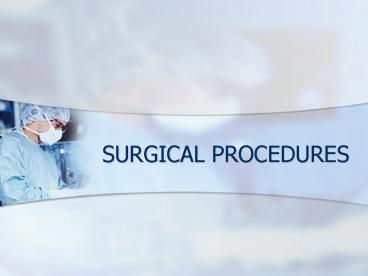SURGICAL PROCEDURES - PowerPoint PPT Presentation
1 / 19
Title:
SURGICAL PROCEDURES
Description:
SURGICAL PROCEDURES ELECTIVE VS. ... too much of the tail TAIL DOCKING POSTOPERATIVE CONSIDERATIONS Return to mother quickly Don t allow dam to lick sutures out! – PowerPoint PPT presentation
Number of Views:134
Avg rating:3.0/5.0
Title: SURGICAL PROCEDURES
1
SURGICAL PROCEDURES
2
ELECTIVE VS. NONELECTIVE
- ELECTIVE PROCEDURES performed at the
veterinarian and owners convenience - Patients are usually healthy
- Examples spay, neuter, declaw
- NONELECTIVE PROCEDURES procedure MUST be done
urgently to improve patients life - Usually emergency procedures
- Animals are usually compromised
- Examples intestinal foreign body removal,
pyometra
3
ELECTIVE VS. NONELECTIVE
- NOTE some surgeries are necessary to improve
quality of life, but are not urgent and it is ok
if the procedure is delayed until conditions are
favorable - EXAMPLES cruciate repair, entropion, ear canal
ablations from chronic otitis, cancer resection
4
ELECTIVE PROCEDURES
5
TAIL DOCKINGS (PUPPIES)
- DEFINITION
- Partial amputation of the tail
- INDICATIONS
- Usually for aesthetic purposes (however can be
done in instances of trauma) - Breed standards set by AKC
6
TAIL DOCKING
- PREOPERATIVE CONSIDERATIONS
- Always consider the dam
- Is she protective?
- Usually provides the warmth/
- food
- Schedule to be performed
- at age 3 -5 days.
- General anesthesia is not performed at this age
- Pick location of procedure carefully-puppies have
a weak immune system
7
TAIL DOCKING
- TECHNIQUE AND INTRAOPERATIVE CONSIDERATIONS
- Puppy should be supported in the palms with the
hind limbs supported between the middle and index
fingers - Rear of puppy is toward the surgeon
- Site is aeseptically prepared
- Exact location is determined and tail is excised
distal to desired location - Hemorrhage is controlled
- Suture placed to oppose the ends of the tail
- Problems with amputating too much of the tail
8
TAIL DOCKING
- POSTOPERATIVE CONSIDERATIONS
- Return to mother quickly
- Dont allow dam to lick sutures out!
- Observe for hemorrhage/early removal of
sutures/redness/drainage/open surgery site - Area can get infected
- Some have to be re-done
9
DEWCLAW REMOVAL (PUPPIES)
- DEFINITION
- Amputation of the claw on the medial aspect of
each limb if present - INDICATIONS
- Aesthetic purposes
- Usually performed at time of tail docking if
necessary - Also perform if there is a known risk of trauma
for the patient (particularly hunting dogs) - Some breeds, such as Great Pyrenees, require the
declaws to be present for showing
10
DEWCLAW REMOVAL
- PREOPERATIVE CONSIDERATIONS
- Same as for tail dockings
- TECHNIQUE AND INTRAOPERATIVE CONSIDERATIONS
- Aeseptically prepare surgery site
- Cradle puppy on its side and extend one leg at a
time toward the surgeon - Dewclaw is excised
- Hemorrhage is controlled (pressure,
electrocautery) - Can either heal by second intention or sutured
closed (silver nitrate, surgical glue)
11
DEWCLAW REMOVAL
- POSTOPERATIVE CONSIDERATIONS
- Return to mother quickly
- Dont allow dam to lick surgical area!
- Observe for hemorrhage/early removal of
sutures/redness/drainage/open surgery site - Area can get infected
12
Tail Docking Dewclaw removal video
http//www.youtube.com/watch?vSyxfYK9dV5E
13
TAIL AMPUTATION AND DEWCLAW REMOVING - adults
- INDICATIONS
- Aesthetics, trauma, infection, neoplasia
- PREOPERATIVE CONSIDERATIONS
- What is reason for surgery?
- Neoplasia Obtain clean margins, submit tissue
for histopathology - Trauma Stabilize patient before procedure
- Infection Culturing of area may be warranted
14
DEWCLAW REMOVAL - adults
- TECHNIQUE AND INTRAOPERATIVE CONSIDERATIONS
dewclaw removal - GENERAL ANESTHESIA required
- Clip, aeseptically prepare site
- Dewclaw is excised at the base (excision extends
through joint, not bone) - Hemorrhage is controlled, skin edges are apposed
with suture - Paw is bandaged to prevent swelling, self trauma
15
DEW CLAW AMPUTATION
16
TAIL AMPUTATION - adults
- TECHNIQUE AND INTRAOPERATIVE CONSIDERATIONS
tail amputation - May also be performed in other animals
- Clipped, aseptically prepared
- Some surgeons prefer for tail to positioned in
air (vertically) - Tourniquet at base of tail is useful for
hemorrhage - Skin is incised, tail is disarticulated at the
joint that was specified (usually skin incision
is distal to disarticulation site to facilitate
closure) - Ligation of blood vessels
- Skin is sutured to cover caudal vertebrae that is
now exposed
17
TAIL AMPUTATION
http//www.youtube.com/watch?vTeKAojeDb4I
18
(No Transcript)
19
TAIL AMPUTATION AND DEWCLAW REMOVAL - adults
- POST-OPERATIVE CONSIDERATIONS
- Tail bandaging is difficult
- Monitor site for hemorrhage/swelling/drainage/redn
ess/self-trauma/dehiscence - Consider placing an Elizabethan Collar
- Skin sutures generally removed in 10-14 days
- Pain meds are important

